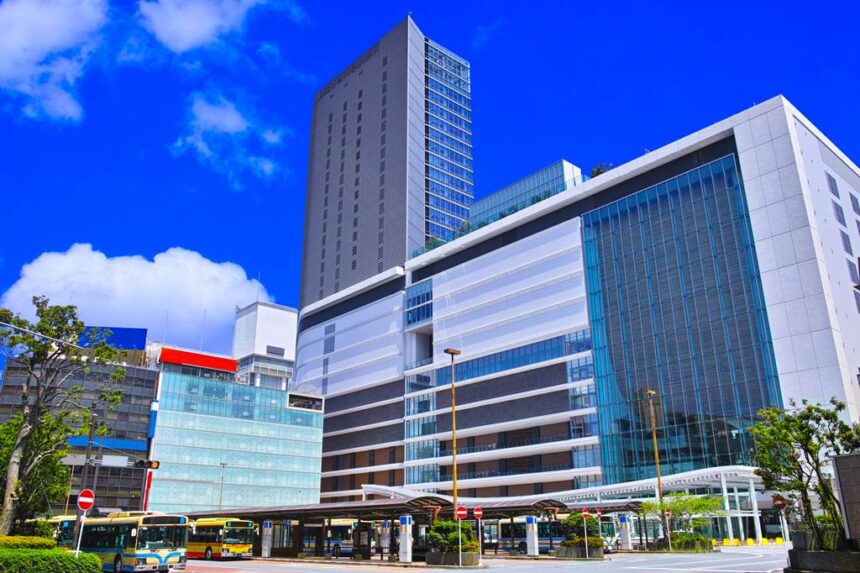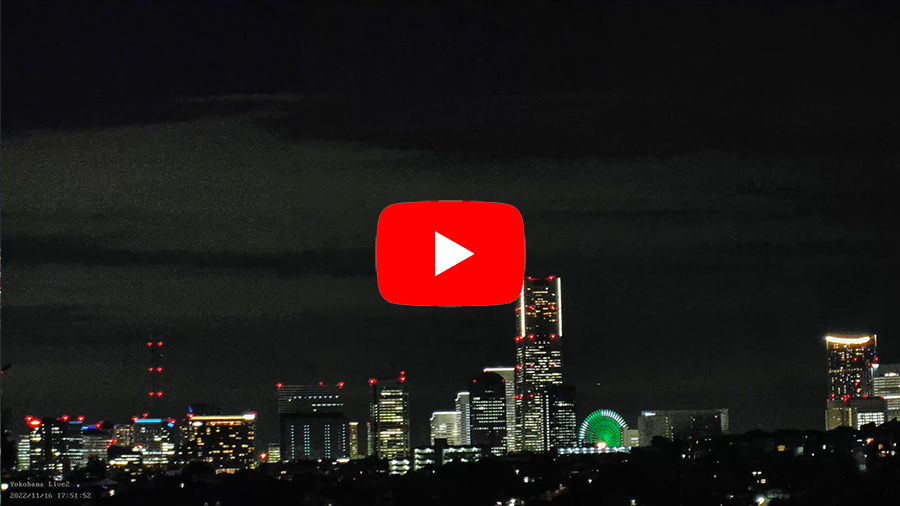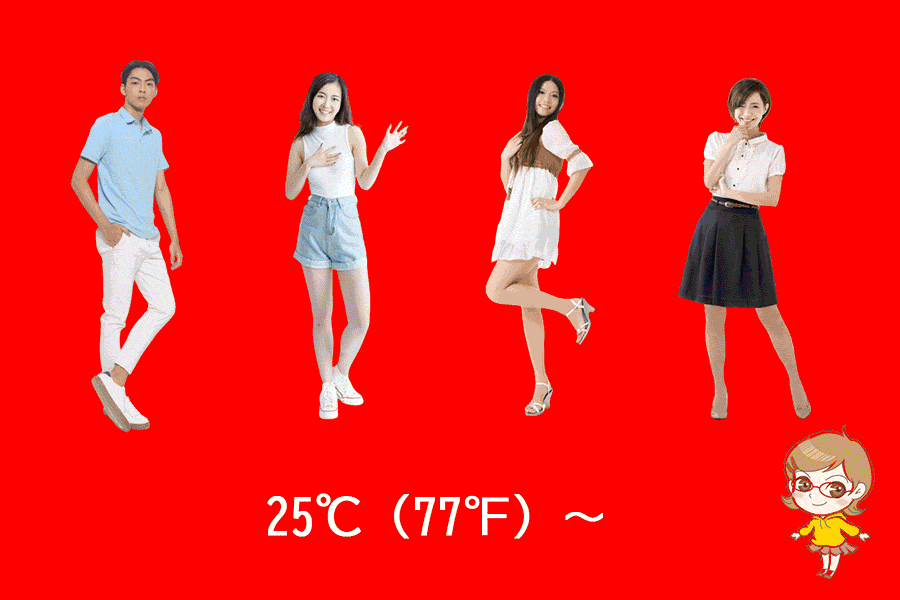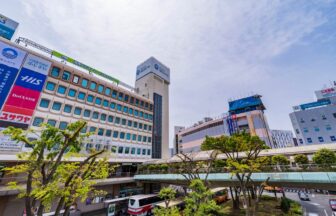2 Chome Takashima, Nishi Ward, Yokohama, Kanagawa 220-0011 MAP
↓ Click to jump to the relevant section.
| Current Weather | Annual Weather | Tourist Attractions |
| Baggage Deposit | Hotels |
Current weather and clothing
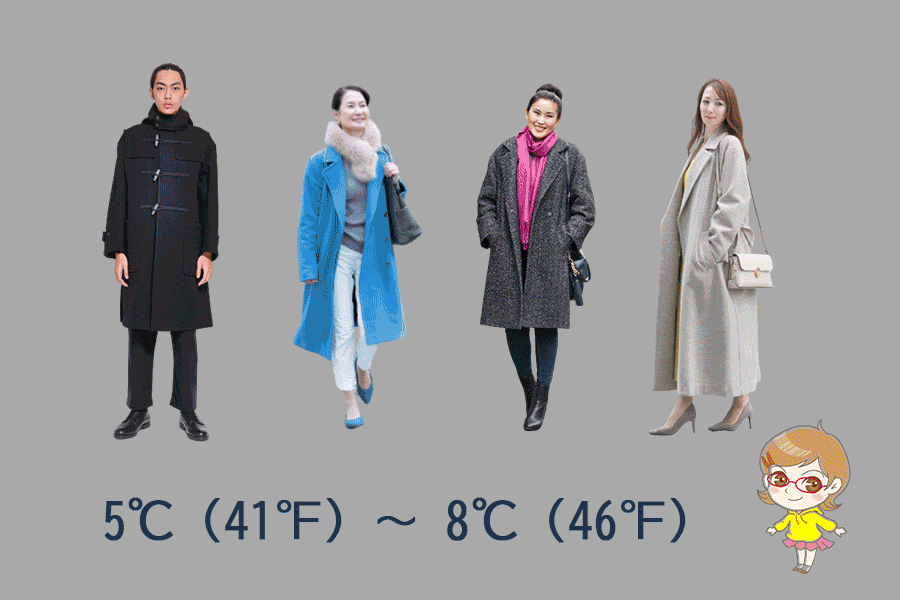
The weather information shown here is the information closest to the station in question. Please note that there may be slight differences.
Yearly temperature changes and recommended clothing
Clothing recommendations for each temperature range
When traveling in Japan with the following average temperatures, the recommended clothing is as follows:
Monthly changes in temperature, precipitation, and snowfall (1991~2020 average, Japan Meteorological Agency survey)
| Jan. | Feb. | Mar. | Apr. | May | Jun. | Jul. | Aug. | Sep. | Oct. | Nov. | Dec. | |
| temperature(°C) | 6.1 | 6.7 | 9.7 | 14.5 | 18.8 | 21.8 | 25.6 | 27 | 23.7 | 18.5 | 13.4 | 8.7 |
| precipitation(mm) | 64.7 | 64.7 | 139.5 | 143.1 | 152.6 | 188.8 | 182.5 | 139 | 241.5 | 240.4 | 107.6 | 66.4 |
| snowfall(cm) | 4 | 4 | 0 | — | — | — | — | — | — | — | — | 0 |
Winter
December
The average temperature in December is around 8.7 °C, and the amount of precipitation is around 66.4 mm. The weather is generally cold. It is recommended to wear warm clothing, such as a thick coat, a sweater, a scarf, gloves, and a hat. Boots or shoes with good traction are recommended for safety.
January
Yokohama Station experiences cold weather in January. The average temperature for the month is 6.1°C. It can get even colder at night and early in the morning, so it is recommended to wear a heavy coat, a scarf, gloves, and a hat. Men and women are advised to wear thermal underwear to keep warm. Long-sleeved shirts and sweaters can also help to keep the body warm.
February
February is still cold in Yokohama Station, with an average temperature of 6.7°C. Snow is rare, but it can happen, so it is important to wear warm clothing. Thick coats, thermal underwear, scarves, gloves, and hats are recommended. Men and women can wear long-sleeved shirts and sweaters to help keep warm. It is important to dress in layers so that clothing can be adjusted to the temperature changes throughout the day.
Spring
March
The temperature starts to warm up in March, with an average of 9.7°C. It is still chilly, especially in the morning and evening, so warm clothing is still necessary. Men and women can wear medium-weight jackets or coats, as well as long-sleeved shirts and sweaters. A scarf, hat, and gloves are still recommended for the colder parts of the day.
April
In April, the temperature continues to rise, with an average temperature of 14.5°C. The weather can be pleasant during the day, but still chilly at night. Light jackets or sweaters are recommended, along with long-sleeved shirts. Men and women can wear pants or skirts, but it is a good idea to wear layers so that clothing can be adjusted to temperature changes.
May
May is a comfortable month in Yokohama Station, with an average temperature of 18.8°C. It is the time of the year when light clothing is preferred. Short-sleeved shirts and light pants are recommended for both men and women. However, it is still a good idea to carry a light jacket or sweater for the cooler nights.
Summer
June
June is the beginning of the rainy season in Yokohama Station. The average temperature for the month is 21.8°C, and humidity is high. It is advisable to carry an umbrella or a raincoat. Men and women can wear light clothing, such as short-sleeved shirts, dresses, and shorts. However, it is a good idea to avoid white clothing because the rainy weather can make it see-through.
July
July is the height of the rainy season in Yokohama Station, with the temperature averaging 25.6°C. It is hot and humid, so it is recommended to wear light and airy clothing. Men and women can wear T-shirts, tank tops, shorts, and light skirts. An umbrella or a raincoat is still necessary, as the rain can be heavy. By late July, the rainy days will diminish and summer will be in full swing. Drink water frequently to prevent heat stroke.
August
August is the hottest month of the year in Yokohama Station, with an average temperature of 27°C. It is important to wear light, breathable clothing to stay comfortable. Men and women can wear T-shirts, shorts, and light skirts. Carry an umbrella because of rainy days.
Autumn
September
In September, the temperature begins to cool down, with an average temperature of 23.7 °C. It is a good time to wear light jackets, as it can still be chilly in the morning and evening. Men and women can wear short-sleeved shirts, light pants, and skirts. September can be a rough weather month as typhoons often pass through the Japanese archipelago. Check the weather forecast.
October
The average temperature in October is around 18.5 °C, and the amount of precipitation is around 240.4 mm. The weather can be unpredictable and varies from sunny days to rainy days. This is due to the frequent approach of typhoons until the first half of October, and from mid-October onward, autumn-like sunny days increase. It is recommended to wear a light jacket or a cardigan for warmth, along with cotton clothing. Comfortable shoes are recommended.
November
The average temperature in November is around 13.4°C, and the amount of precipitation is around 107.6 mm. The weather can be cool, with occasional showers. It is recommended to wear warm clothing, such as a sweater, a coat, or a jacket, along with a scarf, gloves, and a hat to protect from the cold. Warm shoes or boots are recommended.
Recommended tourist destinations
Yokohama Landmark Tower Sky Garden
2-2-1, Minatomirai, Nishi, Yokohama 220-0012 Kanagawa Prefecture
This 296-meter-high skyscraper has offices, a hotel, and a shopping mall at its core, as well as an observation floor and a multipurpose hall. The Sky Garden, located 273 meters above ground, offers a panoramic view of the port city of Yokohama.
YOKOHAMA AIR CABIN
2-1-2 Shinko, Naka-ku, Yokohama 231-0001 Kanagawa Prefecture
YOKOHAMA AIR CABIN, the world’s first 635-meter-long ropeway, connects JR Sakuragi-cho Station with the Canal Park in the Shinko District, allowing visitors to enjoy a walk in the sky while gazing down on Minato Mirai 21 below.
Yokohama Cosmo World
2-8-1 Shinko, Naka-ku, Yokohama 231-0001 Kanagawa Prefecture
The symbol of Minato Mirai, the Giant Ferris Wheel “Cosmo Clock 21,” is located in the urban multi-level amusement park “Yokohama Cosmo World. The world’s first underwater plunge coaster “Vanish! and various other attractions.
Yokohama Red Brick Warehouse
1-1 Shinko, Naka-ku, Yokohama 231-0001 Kanagawa Prefecture
The Yokohama Red Brick Warehouse is a historical brick building constructed in the late Meiji and early Taisho periods. Today, it is a cultural and commercial facility that retains the atmosphere of those days. It is no exaggeration to say that it is “a must-visit place for visitors to Yokohama,” and has become one of Yokohama’s most popular tourist spots.
Cup Noodles Museum Yokohama
2-3-4 Shinko, Naka-Ku, Yokohama 231-0001 Kanagawa Prefecture
The Cupnoodles Museum Yokohama is a popular hands-on museum that attracts more than one million visitors a year.Visitors can enjoy learning about the production process and history of instant ramen through various attractions and exhibits, and also experience the “creative thinking” of Momofuku Ando, the founder of Nissin Foods, who invented the world’s first instant ramen, “Chicken Ramen.
Osanbashi Yokohama International Passenger Terminal
1-1-4 Kaigandori, Naka-Ku, Yokohama 231-0002 Kanagawa Prefecture
It is the gateway to the Port of Yokohama, where large passenger ships from Japan and abroad call at the port.The rooftop of Osanbashi Bridge, known as the “Whale’s Backyard,” is a great spot from which to view the Minatomirai 21 district and Yokohama Bay Bridge. There is also a stylish café and restaurant on the second floor, where the immigration lobby is located.
Sankeien Gardens
58-1 Hommoku Sannotani, Naka-Ku, Yokohama 231-0824 Kanagawa Prefecture
Sankeien Garden is a representative Japanese garden of Yokohama and is designated as a national place of scenic beauty.There are 17 historical buildings in the vast garden, many of which have been relocated from Kyoto and Kamakura and are designated as cultural properties. In the garden, visitors can enjoy seasonal flowers and trees, and it is especially known for its plum blossoms, cherry blossoms, azaleas, and autumn leaves.
Yokohama Chinatown
118-2 Yamashitacho, Naka-Ku, Yokohama 231-0023 Kanagawa Prefecture
Yokohama Chinatown is one of the largest Chinatowns in the world. Lined with Chinese restaurants, fortune tellers, Chinese tea stores, and stores where you can buy Chinese dresses, it is a sightseeing spot where you can feel like you are traveling to China even though you are in Japan.
Yamashita Park
279 Yamashitacho, Naka-Ku, Yokohama 231-0023 Kanagawa Prefecture
It is a popular tourist spot where visitors can take a walk while enjoying beautiful views of Yokohama Port, including the Yokohama Bay Bridge and passing ships. Many roses are in full bloom in the “Future Rose Garden” in the park. Benches lined up in rows facing the sea are perfect for taking a break from strolling around Yokohama.
Yokohama Hakkeijima Sea Paradise
Hakkeijima, Kanazawa-Ku, Yokohama 236-0006 Kanagawa Prefecture
This theme park combines an aquarium with attractions. The centerpiece here is the Aqua Museum, one of the largest aquariums in Japan, where 120,000 creatures from 700 species live in four aquariums. There are many shows and hands-on events, and many opportunities to see marine creatures up close and personal.
Where to leave your luggage
Yokohama Station has a total of 20 coin lockers located both inside and outside the station gates.
The following is an introduction to the largest coin lockers.
(East Exit Coin Lockers) Exit through the JR Central Gate and head for the East Exit. Walk 50 meters to the right after exiting the East Exit, and you will see a row of nearly 400 coin-operated lockers.
Recommended hotels and inns
Yokohama Bay Sheraton Hotel & Towers
1-3-23 Kitasaiwai, Nishi, Yokohama 220-8501 Kanagawa Prefecture
2-minutes walk from Yokohama Station
Hotel class: 4.5
Hotel style: Family , Business
Check Rates & Availability:
>> See on Tripadvisor
>> See on Trip.com
>> See on Expedia
Richmond Hotel Yokohama Ekimae
2-13-7 Tsuruyacho, Kanagawa-Ku, Yokohama 221-0835 Kanagawa Prefecture
3-minutes walk from Yokohama Station
Hotel class: 3
Hotel style: Family , Business
Check Rates & Availability:
>> See on Tripadvisor
>> See on Trip.com
>> See on Expedia
Keikyu Ex Inn Yokohama-eki Higashiguchi
5-7 Kinkocho, Kanagawa-Ku, Yokohama 221-0056 Kanagawa Prefecture
3-minutes walk from Yokohama Station
Hotel class: 3
Hotel style: Centrally Located , Business
Check Rates & Availability:
>> See on Tripadvisor
>> See on Trip.com
>> See on Expedia
Hotel The Knot Yokohama
2-16-28 Minamisaiwai, Nishi, Yokohama 220-0005 Kanagawa Prefecture
7-minutes walk from Yokohama Station
Hotel class: 3
Hotel style: Centrally Located , Business
Check Rates & Availability:
>> See on Tripadvisor
>> See on Trip.com
>> See on Expedia
the square hotel Yokohama Minatomirai
6-3-4, Minatomirai, Nishi, Yokohama 220-0012 Kanagawa Prefecture
13-minutes walk from Yokohama Station
Hotel class: 3
Hotel style: Business
Check Rates & Availability:
>> See on Tripadvisor
>> See on Trip.com
>> See on Expedia
Yokohama Royal Park Hotel
2-2-1-3, Minatomirai, Nishi, Yokohama 220-8173 Kanagawa Prefecture
19-minutes walk from Yokohama Station
Hotel class: 4.5
Hotel style: Quiet , Harbor View
Check Rates & Availability:
>> See on Tripadvisor
>> See on Trip.com
>> See on Expedia
The Yokohama Bay Hotel Tokyu
2-3-7, Minatomirai, Nishi, Yokohama 220-8543 Kanagawa Prefecture
1.0mi/1.6km from Yokohama Station
Hotel class: 5
Hotel style: Modern , Bay View
Check Rates & Availability:
>> See on Tripadvisor
>> See on Trip.com
>> See on Expedia
INTERCONTINENTAL YOKOHAMA GRAND
1-1-1 Minatomirai Nishi-Ku, Minatomirai, Nishi, Yokohama 220-8522 Kanagawa Prefecture
1.0mi/1.6km from Yokohama Station
Hotel class: 3
Hotel style: City View , Modern
Check Rates & Availability:
>> See on Tripadvisor
>> See on Trip.com
>> See on Expedia
InterContinental Yokohama Pier 8
2-14-1 Naka-Ku Shinko, Yokohama 231-0001 Kanagawa Prefecture
1.3mi/2.0km from Yokohama Station
Hotel class: 5
Hotel style: Romantic , Ocean View
Check Rates & Availability:
>> See on Tripadvisor
>> See on Trip.com
>> See on Expedia
APA Hotel & Resort Yokohama Bay Tower
5-25 Kaigandori, Naka-Ku, Yokohama 231-0002 Kanagawa Prefecture
1.4mi/2.3km from Yokohama Station
Hotel class: 4
Hotel style: City View , Business
Check Rates & Availability:
>> See on Tripadvisor
>> See on Trip.com
>> See on Expedia
We support your itinerary planning!
Click the button to get an overview of hotel information and popular tourist routes from all over Japan featured on our site. We’ve included comprehensive details to aid in planning your trip, so please make use of it.
Comprehensive checklist before traveling to Japan

Book flights
Compare and purchase flight tickets
When planning your trip to Japan, it's advisable to start by researching flights several months in advance. Airlines often release promotional fares, especially during off-peak seasons. Use comparison sites like Skyscanner or KAYAK to get a sense of the price range. Be flexible with your travel dates if possible; flying mid-week might be cheaper than on weekends.
>> Visit Skyscanner's official website
>> Visit KAYAK's official website
Order Japan Rail Passes for each family member
Purchase your Japan Rail Pass before departure
The Japan Rail (JR) Pass offers unlimited travel on JR trains, making it a cost-effective option for tourists. However, it's only available to foreign tourists and must be purchased *before* you arrive in Japan. Determine the areas you plan to visit; if you're traveling extensively, a nationwide pass is beneficial, but if you're only exploring a specific region, consider regional JR passes. Children under 12 get a discounted pass, so ensure you order the correct type for each family member.
>>Visit Japan Rail Pass's website
Plan your attire for Japan
Check the weather at your destination on this site
Japanese weather varies significantly by season. In summer, it's hot and humid, so breathable clothes are essential. Winters, especially in the north, can be cold, requiring warm attire. If visiting during the rainy season (June to early July), pack a good umbrella and waterproof shoes. While Japan is generally casual, certain places like temples, shrines, or upscale restaurants may require modest and neat dressing.
Reserve a pocket Wi-Fi or SIM card

SIM card or pocket Wi-Fi is required
Beyond clothes, consider packing essentials like a universal power adapter (Japan uses Type A and B sockets), portable Wi-Fi or SIM card for internet access, and any necessary medications (with a copy of the prescription).
Which is better: a SIM card or pocket Wi-Fi?
When traveling in Japan, one essential to consider is securing internet access, especially given that many locations still don't offer free Wi-Fi. To ensure you can use your smartphone throughout your trip, you'll typically have three options: (1) a SIM card, (2) pocket Wi-Fi, or (3) the roaming service provided by your mobile company. Roaming services can be quite expensive, so we often recommend using a SIM card or pocket Wi-Fi. While SIM cards tend to be more affordable than pocket Wi-Fi, they can be trickier to set up. Pocket Wi-Fi, on the other hand, can be shared among several users, making it a favorable choice for families or groups.
▼SIM card
Advantages:
Relatively affordable.
Disadvantages:
Can be time-consuming to set up initially.
May have strict data limits.
▼Pocket Wi-Fi
Advantages:
Offers substantial data allowances.
A single device can be shared among multiple users.
Easily usable with PCs as well.
Disadvantages:
Typically more expensive.
Japan's representative services

Sakura Mobile's website
▼SIM card
>>Visit Sakura Mobile's official website
>>Visit mobal's official website
▼pocket Wi-Fi
>>Visit Sakura Mobile's official website
>>Visit NINJA WiFi's official website
>>Visit Wi-Fi RENTAL Store's official website
Book local tours as needed
Pre-book your tour and have a great trip!
Local tours offer deep insights into Japan's culture and heritage. Websites like Viator or GetYourGuide offer a variety of tours, from traditional tea ceremonies to modern pop culture tours in Akihabara. Consider unique experiences like staying with monks on Mt. Koya or taking a cooking class to learn authentic Japanese dishes.
>>Visit Viator's official website
>>Visit GetYourGuide's official website
Purchase advance tickets for popular attractions
Make a reservation to avoid crowds
Attractions like Tokyo Disneyland, Universal Studios Japan, or the Studio Ghibli Museum often have long ticket queues. Buy tickets online in advance to save time. Some attractions also have timed entry, so check the specific time slots available and plan accordingly.
▼Tokyo Disney Resort
>>Visit Tokyo Disney Resort official website
>>Visit Viator's Tokyo Disneyland page
>>Visit Viator's Tokyo DisneySea page
>>Visit GetYourGuide's Tokyo Disneyland page
>>Visit GetYourGuide's Tokyo DisneySea page
▼Universal Studios Japan
>>Visit USJ official website
>>Visit Viator's USJ page
>>Visit GetYourGuide's USJ page
Buy travel insurance

insurance concept, health, life and travel insurance
It is important to be prepared for emergencies
While Japan is a safe country, travel insurance is crucial for unforeseen events like health emergencies, travel disruptions, or lost baggage. Ensure your policy covers medical expenses in Japan, as healthcare, though excellent, can be expensive.
Here we introduce online travel insurance services that are popular worldwide.
World Nomads: An online travel insurance service widely endorsed by travelers worldwide. They offer plans that cover adventurous activities and high-risk sports.
>>Visit World Nomads' official website
AIG Travel Guard: An insurance service available to travelers all over the world. They offer a wide range of options, including cancellation protection and emergency medical insurance.
>>Visit AIG Travel Guard's official website
Share your itinerary with emergency contacts
Organize your reservation information
Keep a digital and printed copy of your detailed itinerary, including hotel addresses, train schedules, and booked tours. Share this with a trusted family member or friend not traveling with you.

